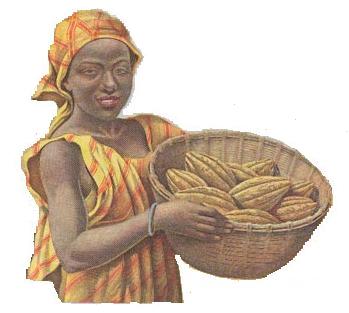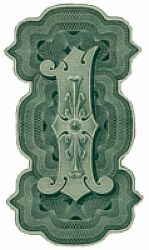Introduction to International Banknote Grading Standards
Grading is the most controversial component of paper money collecting today. Small differences in banknote grade can mean significant differences in value. The process of grading is so subjective and dependant on external influences such as lighting, that even a very experienced individual may well grade the same note differently on separate occasions.
 ?
? 
To facilitate communication between sellers and buyers, it is essential that grading terms and their meanings be standardized and as widely used as possible. This standardization should reflect common usage as much as practicable. One difficulty with grading is that even the actual grades themselves are not used every place and by everyone. For example, in Europe the grade “About Uncirculated” (AU) is not in general use, yet in North America it is widespread. The European term “GoodVF” may roughly correspond to what individuals in North America would call “EF”.
The grades and definitions as set forth below cannot reconcile all the various systems and grading terminology variants. Rather, the attempt is made here to try and diminish the controversy with some common sense grades and definitions that aim to give more precise meaning to the grading language of paper money.
Grade Relating to Price
 Generally speaking, the higher the grade of a banknote, the more money that banknote will command on the open market. Also, original banknotes generally command higher prices than cleaned or doctored banknotes. Most catalogues will attempt to give pricing information in various grades as a guideline to what the current market will bear, however, most catalogues in the banknote hobby are woefully trailing actual market prices. Most collectors will attempt to purchase banknotes for their collection in the highest grade possible and then keep their eyes open for better grades as time goes by upgrading whenever possible.
Generally speaking, the higher the grade of a banknote, the more money that banknote will command on the open market. Also, original banknotes generally command higher prices than cleaned or doctored banknotes. Most catalogues will attempt to give pricing information in various grades as a guideline to what the current market will bear, however, most catalogues in the banknote hobby are woefully trailing actual market prices. Most collectors will attempt to purchase banknotes for their collection in the highest grade possible and then keep their eyes open for better grades as time goes by upgrading whenever possible.
As the number of banknote collectors increase, this "drive for high grades" tends to push the market prices for scarce high grade notes to levels much higher than expected. For example a banknote may be priced at $100 for a VG, $250 for a VF and $800 for an UNC. The reason for this can be summed up as simple "supply and demand". There are far more banknotes surviving in lower grades.
Most scarce and rare banknotes may not even be available in extremely high grades. In cases such as this, the pricing may be more like $100 for a VG, $250 for a VF and un-priced in UNC. If an UNC banknote does become available, it will normally be sold either at auction or privately to an informed buyer who understands the rarity of this note in this grade.
How to Look at a Banknote
In order to ascertain the grade of a note, it is essential to examine it out of a holder and under a good light. Move the note around so that the light bounces off at different angles. Try holding it up obliquely so that the note is almost even with your eye as you look up at the light. Hard-to-see folds or slight creases will show up under such examination. Some individuals also lightly feel along the surface of the note to detect creasing.
Cleaning, Washing, Pressing of Banknotes
Cleaning, washing or pressing paper money is generally harmful and reduces both the grade and the value of a note. At the very least, a washed or pressed note may lose its original sheen and its surface may become lifeless and dull. The defects a note had, such as folds and creases, may not necessarily be completely eliminated and their telltale marks can be detected under a good light. Carelessly washed notes may have white streaks where the folds or creases were (or still are).
Processing of a note which started out as Extremely Fine will automatically reduce it at least one full grade.
Glue, tape, or pencil marks may sometimes be successfully removed. While such removal will have a cleaned surface, it will improve the overall appearance of the note without concealing any of its defects. Under such circumstances, the grade of the note may also be improved.
The words “pinholes”, “staple holes”, “trimmed”, “writing on face”, “tape marks”, "tears", etc. should always be added to the description of a note. It is realized that certain countries routinely staple their notes together in groups before issue. In such cases, the description can include a comment such as “usual staple holes” or something similar. After all, not everyone knows that such-and-such a note cannot be found otherwise.
The majour point of this section is that one cannot lower the overall grade of a note with defects simply because of the defects. The price will reflect the lowered worth of a defective note, but the description must always include the specific defects.
The Term "Uncirculated"
The word “Uncirculated” is used in this grading guide only as a qualitative measurement of the appearance of a note. It has nothing at all to do with whether or not an issuer has actually released the note to circulation. Thus the term “About Uncirculated” is justified and acceptable because so many notes that have never seen hand-to-hand use have been mishandled so that they are available in, at best, AU condition. Either a note is uncirculated in condition or it not; there can be no degree of uncirculated. Highlights or defects in color, centering and the like may be included in the description but the fact that a note is or is not in uncirculated condition should not be a disputable point.

Grading Guide – Definition of Terms
UNCIRCULATED (UNC): A perfectly preserved note, never mishandled by the issuing authority, a bank teller, the public or a collector. Paper is clean and firm, without discoloration. Corners are sharp and square, without any evidence of rounding, folding or bending. No light handling is present, no compromise, a perfect note. An uncirculated note will have its original, natural sheen.
NOTE: Some note issues are most often available with slight evidence of very light counting folds which do not "break" the paper. Also French-printed notes usually have a slight ripple in the paper. A banknote that has less than perfect corners is considered nearly uncirculated. Many collectors and dealers refer to such notes as AU-UNC.
ABOUT UNCIRCULATED (AU): A virtually perfect note, with some minor handling. May show very slight evidence of bank counting folds at a corner or one light fold through the center, but not both. An AU note can not be creased, a crease being a hard fold which has usually "broken" the surface of the note. Paper is clean and bright with original sheen. Corners are not rounded.
EXTREMELY FINE (EF/XF): A very attractive note, with light handling. May have a maximum of three light folds or one strong crease. Paper is clean and bright with original sheen. Corners may show only the slightest evidence of rounding. There may also be the slightest sign of wear where a fold meets the edge.
VERY FINE (VF): An attractive note, but with more evidence of handling and wear. May have several folds both vertically and horizontally. Paper may have minimal dirt, or possible colour smudging. Paper itself is still relatively crisp and floppy. There are no tears into the border area, although the edges do show slight wear. Corners also show wear but not full rounding.
FINE (F): A note which shows considerable circulation, with many folds, creases and wrinkling. Paper is not excessively dirty but may have some softness. Edges may show much handling, with minor tears in the border area. Tears may not extend into the design. There will be no center hole because of excessive folding. Colours are clear but not very bright. A staple hole or two would not be considered unusual wear in a Fine F note. Overall appearance is still on the desirable side.
VERY GOOD (VG): A well used note, abused but still intact. Corners may have much wear and rounding, tiny nicks, tears may extend into the design, some discoloration may be present, staining may have occurred, and a small hole may sometimes be seen at center from excessive folding. Staple holes and pinholes are usually present, and the note itself is quite limp but NO pieces of the note can be missing. A note in VG condition may still have an overall not unattractive appearance.
GOOD (G): A well worn and heavily used note. Normal damage from prolonged circulation will include strong multiple folds and creases, stains, pinholes and/or staple holes, dirt, discoloration, edge tears, center hole, rounded corners and an overall unattractive appearance. No large pieces of the note may be missing. Graffiti is commonly seen on notes in G condition.
FAIR (FR): A totally limp, dirty and very well used note. Larger pieces may be half torn off or missing besides the defects mentioned under the Good category. Tears will be larger, obscured portions of the note will be bigger.
POOR (PR): A "rag" with severe damage because of wear, staining, pieces missing, graffiti, larger holes. May have tape holding pieces of the note together. Trimming may have taken place to remove rough edges. A Poor note is desirable only as a "filler" or when such a note is the only one known of that particular issue.
NOTE: Grades and intermediate grades that are used by collectors and dealers all around the world: Poor, Fair, aGood, Good, Good+, G-VG, aVG (or VG-), VG, VG+, VG-F, aFine (or F-), Fine, Fine+, F-VF, aVF (or VF-), VF, VF+, VF-XF, aXF (or XF-), XF (or EF), XF+, XF-AU, aAU (or AU-), AU, AU+, AU-UNC, aUNC (or UNC-), UNC.
GRADING TABLE || STANDARD INTERNATIONAL GRADING TERMINOLOGY || SHELDON GRADING SCALE (not our favourite - it needs improvements - we have added grades 4 and 2 so far)
France - Republique Francaise
NEUF - New
SPL - Splendide
SUP - Superbe
TTB - Tres Tres Beau
TB - Tres Beau
B - Beau
TBC - Tres Bien Conserve
BC - Bien Conserve
Germany - Bundesrepublik Deutschland
BFR - Bankfrisch
VZGL - Vorzüglich
SS - Sehr Schön
S - Schön
SG - Sehr Gur erhalten
G - Gut erhalten
GS - Gering erhalten Schlecht
Italy - Republica Italiana
FdS - Fiore di Stampa
SPL - Spledido
BB - Bellissimo
MB - Molto Bello
B - Bello
M - Mediocre
Lithuania - Lietuva
NP - Nepriekaistingas
YP - Ypatingai Puikus
LP - Labai Puikus
P - Puikus
LG - Labai Geras
G - Geras
M - Menkas
Netherlands - Nederland
UNC - Ongecirculeerd
PR - Prachtig
ZF - Zeer Frai (Zeer Mooi)
F - Fraai (Mooi)
ZG - Zeer Goed
G - Goed
Spain - España
EBC - Extraordinariamente Bien Conservada
SC - Sin Circular
IC - Incirculante
MBC - Muy Bien Conservada
BC - Bien Conservada
RC - Regular Conservada
MC - Mala Conservada
Numeric Scale vs. IBNS
10 = UNC
9 = AU
8 = XF
7 = VF-XF
6 = VF
5 = F-VF
4 = F
3 = VG
2 = G
1 = FR
0 = PR




Information sources:
Banknotes.com own creativity
International Bank Note Society Membership Directory. June 1996 Edition.
"Standard Catalogue of World Paper Money. Volume II - General Issues to 1960. Eighth Edition". By Albert
PICK, Colin R. Bruce II, Neil Shafer, George S. Cuhaj. Published by Krause Publications, Inc.




